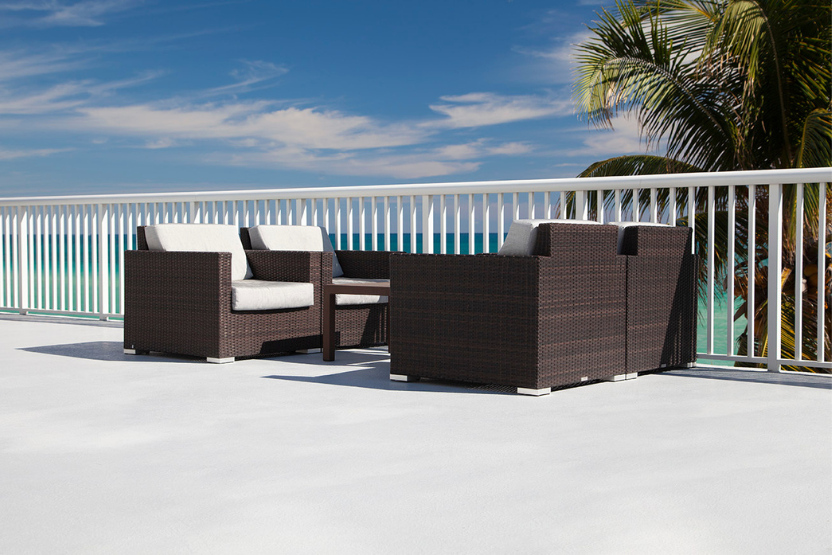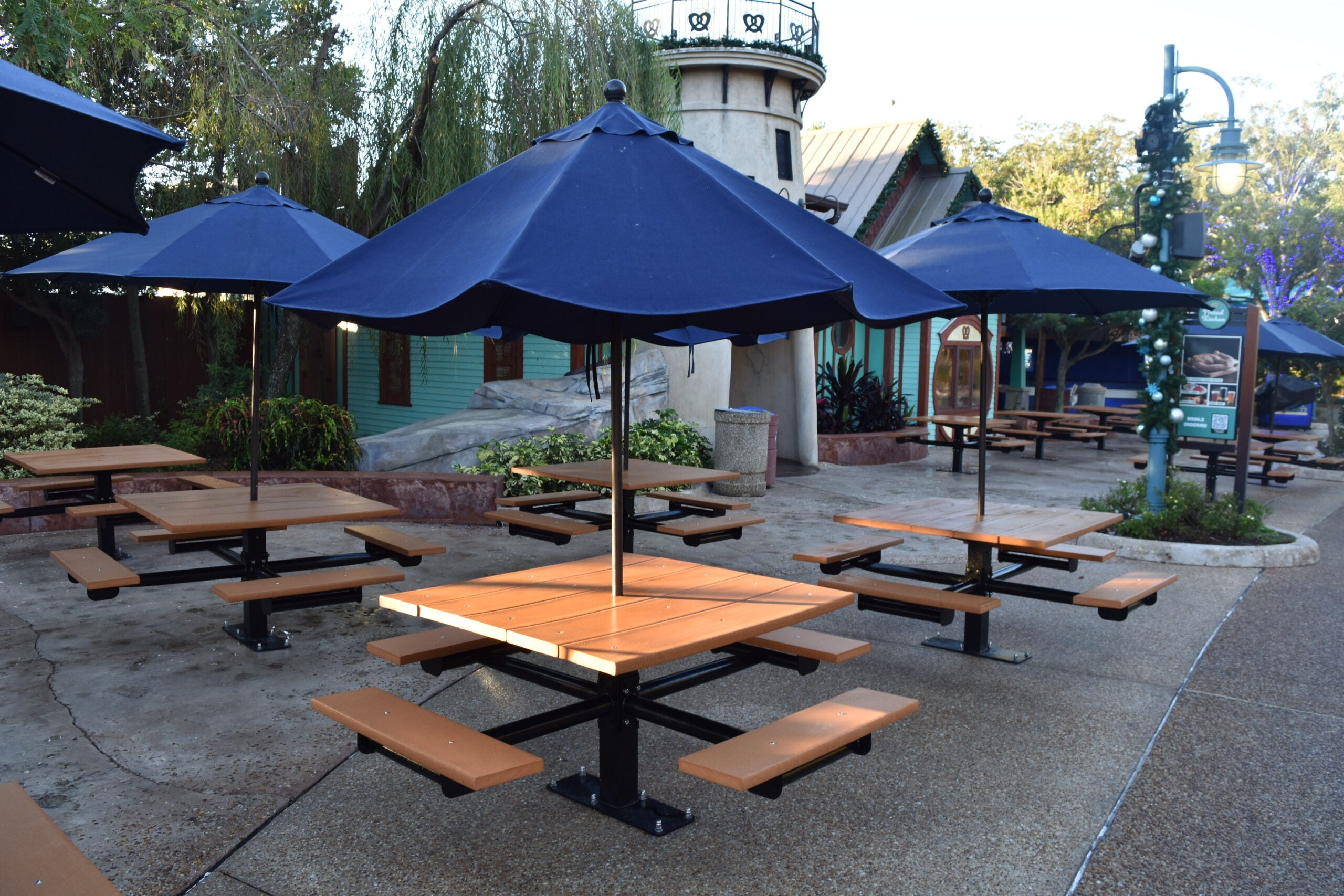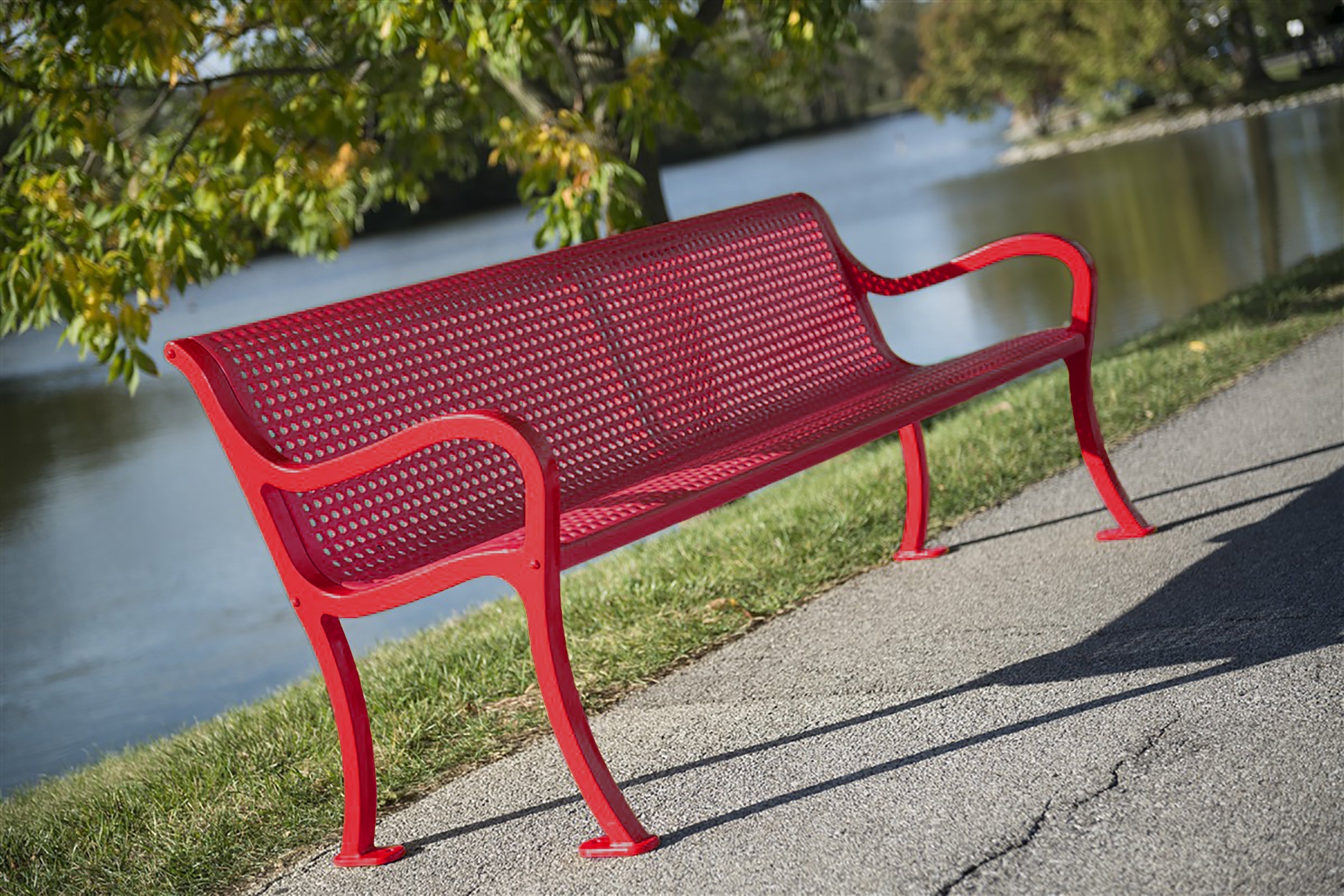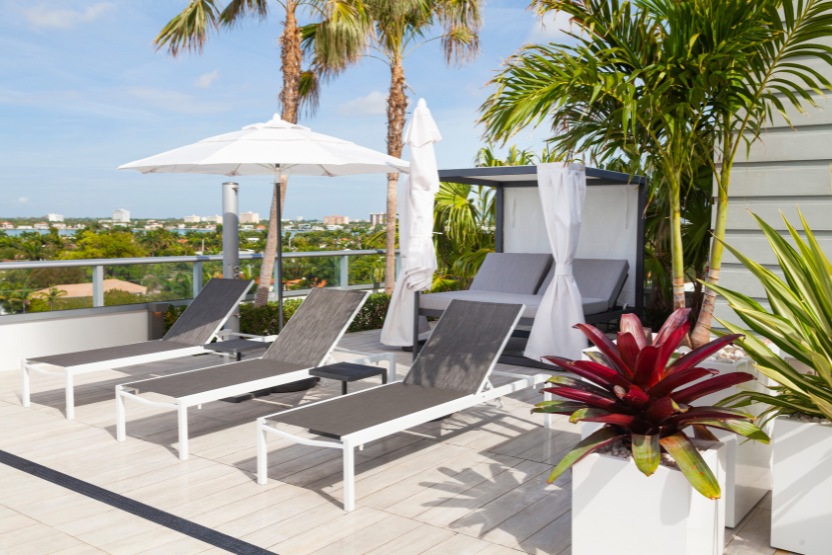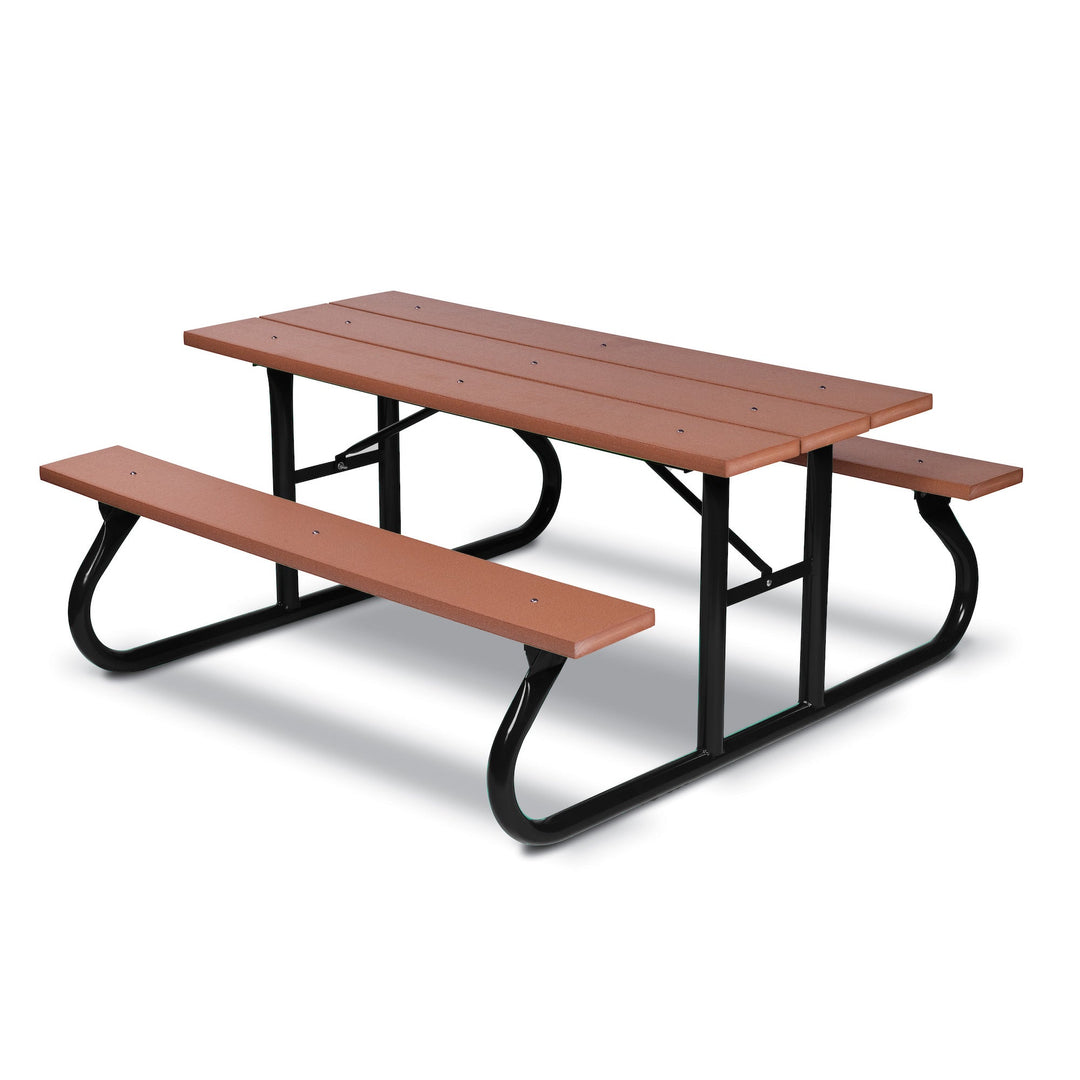How to Choose the Best Material for Outdoor Furniture
Consider an outdoor seating area with patio tables and chairs. What feeling does the space give you when the chairs are made from wood? Is it different when they’re made from plastic?
The furniture materials we choose can change the look and feel of a space completely. Materials also impact the long-term performance of your furniture, so you should always shop with durability in mind.
Outdoor Furniture Materials Explained
Before you can compare, you must know what’s out there. Here are some of the most popular materials for residential and commercial outdoor furniture.
Wood
Wooden patio furniture has a timeless appearance. Outdoor furniture is usually made from woods like teak (the most durable option), cedar, oak, or redwood. Wooden outdoor furniture requires regular maintenance — polishing, oiling, and sealing. It should be kept away from moisture and harsh sunlight.
Rattan
Rattan is a tropical vine that can be dried and woven into furniture. It has a rustic, bohemian look that brings outdoor spaces to life. It’s lightweight and sturdy; however, it is sensitive to moisture. Caring for rattan furniture involves regular brushing to remove dirt from the weave. It’s best to store it indoors during humid weather.
Aluminum
Aluminum is the best outdoor furniture material for coastal areas. Unlike other metals, aluminum does not rust. Instead, it forms a protective oxide layer when confronted with moisture. It’s a lightweight, low-maintenance material that requires only occasional cleaning. It can be anodized or powder-coated to give it a bright, colourful finish.
Steel
Steel furniture is sturdy and durable; ideal for commercial spaces and high-traffic areas. It’s heavier than aluminum and provides more durability; however, it does require more upkeep. Carbon steel needs regular cleaning and treatment to prevent rust. Stainless steel is a rustproof option, but it comes at a higher price.
Plastic
Many furniture makers now offer synthetic imitations of wood and rattan furniture. These “wood look” pieces are far more moisture-resistant and require almost no maintenance. Another popular type of plastic for patio furniture is high-density polyethylene (HDPE). HDPE is strong, durable, and widely recycled.
Choose the Best Outdoor Furniture Material for Your Climate
The first and most important thing to consider when buying outdoor furniture is how the weather might affect it. Weather-resistance is key to longevity. When it comes to climate, there are three aspects to consider: UV, moisture, and temperature.
UV Resistance
The sun emits ultraviolet (UV) radiation every day, no matter the weather. Over time, UV degrades materials and causes fading and discoloration in your patio furniture. It can also lead to brittleness and cracking. If you live in an area with a high UV index on average, you will need hardy furniture treated with a UV-resistant coating.
Moisture Resistance
Natural materials like wood and rattan swell when exposed to water, and they need to dry completely between rainstorms. Moisture can also wreak havoc on untreated metal, causing it to rust. In high-humidity areas, mold becomes a concern and patio furniture often does better with synthetic materials.
Temperature Resistance
In areas with extreme temperature fluctuations – like arid or semi-arid regions – furniture materials expand and contract very quickly. This can cause microcracks and weaken joints and seams. Extreme cold can cause furniture to freeze and become very brittle, especially flexible plastics. When temperatures rise, metal furniture can quickly become uncomfortably hot to the touch, making outdoor seating less inviting on sunny days.
Understand the Maintenance Requirements of Different Materials
The best material for outdoor furniture is one that matches your appetite for cleaning and maintenance. Having high-maintenance furniture only works when you make the time to dust it, treat it, and even resurface it where necessary.
-
Wood requires some TLC. You’ll need to oil your wooden furniture once or twice a year to keep it looking shiny and warm. Sanding it down and resurfacing it every few years does wonders for furniture longevity.
-
Rattan is very sensitive to UV and moisture and does better under cover. It will require regular cleaning if used outdoors and must be moved indoors when it rains.
-
Aluminum is a low-maintenance metal that only requires an occasional wipe-down to remove salt residue (in coastal areas) and dirt. Check the finish once a year.
-
Steel needs to be covered with a protective coating to prevent rust. Painted steel will need regular inspections and touch-ups. Peeling or cracking paint leaves the metal below vulnerable to corrosion.
-
Plastic is quite hardy and shouldn’t take too much maintenance. Dirt can cling to plastic, so you’ll need to wash your furniture regularly. Applying UV spray during the summer helps protect the plastic from sunlight that causes discoloration.
How and Where Will You Use the Furniture?
Just because furniture has excellent weather resistance and minimal maintenance requirements doesn’t mean it will suit your space. Aesthetics and usability are important too. Different environments have different needs — the best patio furniture material may not be the best material for public parks.
Commercial vs Residential Spaces
Commercial outdoor furniture is built to withstand constant exposure to the elements, very little maintenance, and even misuse. It’s hardy, sturdy, and often heavyweight or bolted to the floor. Good material choices are recycled plastic and powder-coated or plastisol-coated steel.
Residential and resort outdoor furniture needs to look and feel more upscale. This is where natural materials like teak wood shine. Upholstery is used for softness and comfort, and synthetic wicker makes natural-looking outdoor sofas more durable.
Heavy Use vs Light Use
Furniture in a backyard will be used much less than furniture in a public park, school, or shopping mall. The heavier the intended use, the more durable the materials need to be. If you’re buying outdoor furniture for a busy, crowded place, choose materials like plastisol-coated steel, aluminium, and plastic. Wood, upholstery, and rattan are more delicate and better suited to light use.
Compare the Lifecycle Costs of Outdoor Furniture Materials
Why is patio furniture so expensive? You’re often paying for durability and comfort. While there are plenty of budget-friendly outdoor furniture options, you may end up paying more in maintenance and replacement costs.
Find the best material for your outdoor furniture budget using the lifecycle cost analysis below.
|
Material |
Initial Cost (mid-range patio set) |
Maintenance Costs/year |
Annualized Replacement Cost (cost/average lifespan) |
Overall Value Score (1 - 10) |
|
Teak wood |
~$3,500 |
$150 |
$220/year |
8 |
|
Cedar wood |
~$800 |
$50 |
$103/year |
6 |
|
Ipe wood |
~$3,000 |
$50 |
$110/year |
8 |
|
Redwood |
~$1,200 |
$150 |
$198/year |
5 |
|
Natural rattan |
~$3,000 |
$120 |
$420/year |
4 |
|
Bamboo |
~$500 |
$40 |
$90/year |
5 |
|
Aluminum |
~$1,200 |
$20 |
$80/year |
8 |
|
Painted steel |
~$900 |
$50 |
$110/year |
6 |
|
Plastisol-coated steel |
~$800 |
$30 |
$70/year |
7 |
|
HDPE plastic |
~$2,000 |
$20 |
$100/year |
8 |
|
Recycled plastic |
~$1,500 |
$15 |
$65/year |
9 |
Protective Coatings to Extend the Lifespan of Outdoor Furniture
Adding a surface treatment to outdoor furniture protects the inner material from the elements. Strong materials like hardwood and steel have a weakness when it comes to moisture. Plastics are susceptible to sun damage. Furniture coatings create a barrier against harsh weather. This reduces the need for maintenance and aesthetically enhances the furniture.
Plastisol
Plastisol is a liquid form of PVC that cures into a firm plastic. Manufacturers dip steel furniture parts into plastisol to coat the metal and seal it against air and moisture. This gives furniture the sturdiness of steel and the durability of plastic. Plastisol-coated furniture is a reliable, high-performance choice engineered for commercial longevity.
Powder Coating
Powder coating is a resin layer that protects metal furniture from corrosion. It is applied to the metal as a dry powder and heated to form a tough film around the furniture. Powder coating often contains UV stabilizers that protect the furniture from harsh sunlight. It comes in many different colors that are “baked” into the metal, eliminating the need for repainting.
Polyurethane
Polyurethane is a plastic varnish that can be painted onto wooden and metal furniture. It protects the core material from moisture and sunlight and makes it more scratch-resistant. Polyurethane can be applied at home and is best for patio furniture. The material is more accessible and affordable than industrial surface coatings.
Read More: Polyethylene vs. Plastisol Coated Outdoor Furniture
Outdoor Furniture Buyer’s Checklist
Finding the best outdoor furniture material doesn’t have to take ages. Here’s what to look for, ask, and think about before you make a purchase.
Material Understanding
-
What is the furniture made of?
-
Has it been treated or coated?
-
What is the outer coating made of?
Furniture Use
-
Where will the furniture live?
-
Is it for home or commercial use?
-
Will it be covered or in full sun?
Your Climate
-
Sunny: Is it coated with a UV stabilizer?
-
Coastal: Is it rust-proof and mold-proof?
-
Arid: Look for thicker materials with flexible coatings.
-
Rainy: How long will it take to dry? Avoid absorbent materials.
Maintenance Needs
-
How often will I realistically clean and treat the furniture?
-
Where do I buy the right care products? (wood oils, PU coatings, etc.)
-
Is maintenance easy, or will I need outside help?
Costs and Value
-
What is the expected lifespan of this furniture material?
-
Can I easily replace just one part of the furniture? (Legs, slats, etc.)
-
How much will it cost me to maintain the furniture every year?
Shop High-End Commercial Furniture for Outdoor Spaces
Wabash Valley is a trusted supplier of plastisol-coated steel furniture for parks, schools, and commercial spaces. Shop online for park benches, trash cans, picnic tables, bike racks, umbrellas, and more. Feel free to reach out for more information.
